Below are details of local plants, illustrated by the tiles by Bronwyn Williams-Ellis that decorate our campsite facilities. Many thanks to Rhodri Thomas for detail about these.
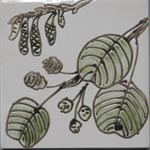
Alder
Alder[Gwernen](Alnus glutinosa): A common native tree locally, with many specimens around the campsite and in surrounding woodland. Alder grows in wet ground aided, in these often nitrogen-deficient soils, by bacteria living in the roots which absorb nitrogen from the air. In the past alder was used for making clogs due to its water-resistant properties and was coppiced for charcoal and making gunpowder. In Welsh legend it was associated with the giant Brân the Blessed, king of Britain, whilst in Norse legend the first woman was made from Alder.

Ash
“The Llyn Gwynant Barns had everything we were looking for in a wedding venue: stunning scenery, a place for our guests to camp to really make a weekend of it, and a space that we could decorate exactly how we wished. Ash [Onnen](Fraxinus excelsior): A common tree in the woodland on the campsite and beyond, the Ash is tall and beautiful and relatively late coming into leaf in the spring. The wood burns well and was used in the past for tool handles and furniture. Ash thrive on less acid soils than Oak. In Norse legend Odin created the first man from an Ash tree.

Birch
Birch [Bedwen](Betula sp.): Another common native tree that grows on the campsite and in surrounding woodland, as it likes acidic soils. Birch are quick growing and a first coloniser of land fenced off from grazing. There are two common species- the Silver Birch which grows on drier ground and the Downy Birch which prefers damper areas. In Scotland the sugary sap is used to make wine.

Bluebell
Bluebell [Clychau’r Gog](Hyacinthoides non-scripta): The common bluebell flowers in spring, and is common in woodlands near the campsite. They flower under trees in deciduous woodland before the leaves are too shady, sometimes in places that later get filled with bracken. Bluebells are a particularly British plant, thriving in our mild climate- indeed Britain may support as much as half the world population.
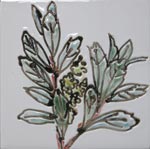
Bogmyrtle
Bogmyrtle (Myrica gale), also called sweet gale, grows in acidic peat bogs on the hillsides above the campsite. To cope with these difficult nitrogen-poor growing conditions, the roots have nitrogen-fixing actinobacteria which enable the plants to grow. This herb, which is also native to Scotland, is used as a midge repellant.
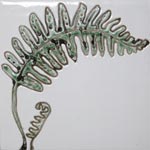
Common polypody
Common polypody (Polypodium vulgare) is a fern with triangular leaflets measuring 10 to 50 centimetres divided all the way back to the central stem in 10 to 18 pairs of segments or leaflets.Commonly used in cooking for its aroma and sweet taste.
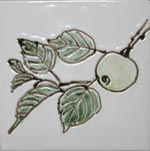
Crabapple
Crabapple small trees with small and sour tasting fruit that visually resemble a small apple, but are not eated raw because of being so sour.
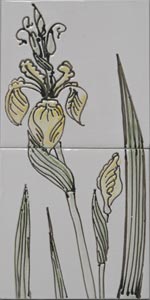
Flag iris
Flag iris [Gellesgen](Iris pseudacorus): Also known as Yellow Flag or Yellow Iris, this plant grows 1 to 1½ m high in wetlands, with flowers 7 to 10 cm long. It can even grow submerged, and is common locally. The leaves contain poisonous glycosides and it is therefore usually avoided by grazing animals. The Fleur-de-lis symbol is widely considered to be a stylisation based on the Flag Iris.

Foxglove
Foxglove [Bysedd y cwn](Digitalis purpurea): The common purple foxglove thrives in acidic soils and so is frequently seen around the campsite and in local woodland. It flowers only in its second year. The name comes from a series of corruptions of ancient words, glove coming from ‘gliew’ – a musical instrument with many small bells – and fox from ‘folk’s’ meaning little folk or fairies. A more literal meaning is reflected in the tale that mischievous fairies gave the plant to the fox, so that he could slip the flowers on his feet and approach chicken runs quietly. The plant contains a drug, digitalis, which is useful in the treatment of heart complaints but in large doses is poisonous.
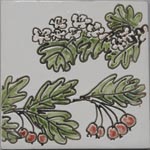
Hawthorn
Hawthorn [Draenen wen](Crataegus manogyna): A common small shrub or tree on the hillsides around the campsite and common in campsite hedgerows. These are important providers of shelter to many plants and animals. The name hawthorn comes from the Anglo-Saxon haegthorn, reflecting its widespread use as a hedging plant. Hawthorn is one of the 9 flowers from which the Welsh goddess of spring Blodeuwedd was made.
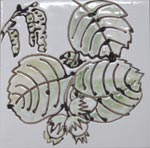
Hazel
Hazel [Collen](Corylus avellana): Hazels are common in the hedgerows of the campsite. They have serrated heart shaped leaves and the trees are an important food source as well as shelter for local wildlife.

Holly
Holly [Celynnen](Ilex europaeus): A slow growing evergreen that is common locally. Despite its prickly leaves, holly was once highly valued as winter fodder for livestock- for example the 13th century Dream of Rhonabwy, from the Mabinogion, refers to a house with “branches of holly a-plenty on the floor after the cattle had eaten off their tips”. The campsite field Pen Helen was likely originally to have been called Pen Helm, ‘Helm’ being a Welsh name for holly, and it is possible that a copse of holly was deliberately grown here for winter fodder in the past, as in other parts of the country.
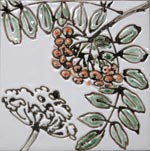
Rowan
Rowan [Criafolen](Sorbus aucuparia): Also known as the Mountain Ash or Quicken Tree, these small deciduous trees grow in hedgerows on the campsite as well as in surrounding woodland. Its berries are a favourite food for many birds and were traditionally collected by people too.
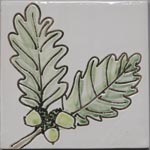
Oak
Sessile oak [Derwen mes di-goes](Quercus petraea): These slow growing trees are common locally, with many specimens on the campsite and surrounding woodland. Sessile oak are more domed in shape and not as large as the English oak. The wood was used for building. The humid oakwoods of Nant Gwynant and other sites in western Britain form Temperate Rainforest- one of the few areas in the world where this habitat can be found.

Sloe
Sloe [Draenen ddu](Prunus spinosa): Also called blackthorn, these bushes have dense spiny branches and the fruit is similar to a damson though very tart in taste. Blackthorn makes an excellent firewood that burns slowly with a good heat and little smoke. The berries are used to make sloe gin, a liqueur. It flowers in early spring, and its flowering was often thought to be associated with the onset of cold conditions again- a “Blackthorn winter”.
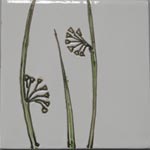
Rush
Soft rush [Brwynen Babwyr ](Juncus effusus): This is the common rush you see widely on the campsite and locally. The soft core of the rush was in the past soaked in grease to make ‘rush-lights’, a cheap substitute for candles in most rural cottages well into the 19th century. The naturalist Gilbert White noted that “a good rush…burnt only three minutes short of an hour”. They were also widely used on the floors of houses and churches.

Sycamore
Sycamore [Masarnen](Acer pseudoplatanus): The sycamore maple was introduced to the UK from central Europe by the Romans and is now common locally. The tall tree has a dense shade, and may thrive here with climate change. Locally it was planted around farmhouses and cottages because of its large sheltering canopy.
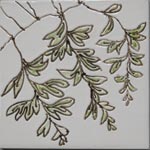
Wilsons filmy fern
Wilson’s Filmy-Fern [Rhedynach teneuwe Wilson](Hymenophyllum wilsonii): This is a rare plant in the UK, but can be found along one local stream. An ancient plant, it grows only in very damp places, wetted by spray from waterfalls or streams, and is one of the specialist plants characteristic of the humid “temperate rainforest” oakwoods of western Britain. Elsewhere it is restricted to other areas with a highly oceanic (mild damp) climate- SW Norway, NE Spain and Portugal, the Canary Isles and the Azores. It grows in dark green clumps and, with its small thin translucent green fronds, looks a little like a moss or liverwort.
